How Power Distribution Systems Work
Table of Contents
ToggleThe three primary parts of an electric power distribution system are distribution, transmission, and generation. Generation refers to the portion of energy produced in an electric power plant. Transmission includes electric power transmission lines. Distribution includes electric power distribution lines.

Fundamental Parts of Electric Power Distribution System.
Generation of Electric Power
The three primary parts of an electric power distribution system are distribution, transmission, and generation. Generation refers to the portion of energy produced in an electric power plant. Transmission includes electric power transmission lines. Distribution includes electric power distribution lines.
An extensive array of equipment, comprising bus bars, circuit breakers, current transformers, potential transformers, power transformers, surge arrestors, isolators, insulators, earth pits, and so on, is installed in the producing sub-station. Producing electric energy can be done in a lot of ways. There are two sections to each of these methods.
Components of Power Distribution Systems:
In order to transport electricity from power plants to consumers, power distribution systems are made up of a number of interconnected components:
- Transmission Lines: Power plants and substations are connected by high-voltage transmission lines that carry electricity across great distances.
- Substations: Where voltage levels are changed for distribution or transmission, substations play a crucial role in the distribution network.
- Distribution Lines: Substations supply power to end users, such as businesses, homes, and industries, via low-voltage distribution lines.
- Transformers: Stepping down high-voltage power for distribution and stepping it up for transmission, transformers are essential to voltage regulation.
Maintaining a reliable and effective power distribution system requires an understanding of the roles and interactions between these parts.
(a) Convensional Method
With this technology, a prime mover is turned by a gas turbine, diesel engine, steam engine, gas turbine, or hydraulic turbine. The alternator, an electric device, is coupled to this revolving prime mover. Alternating electricity is produced by this alternator when it revolves with the prime mover.
We are aware that energy cannot be generated or destroyed; instead, it can only be changed from one type of energy to another. Chemical energy is changed into mechanical energy when a diesel or gasoline engine rotates the prime mover. A diesel or petrol power plant is the process used to generate electricity.
With this approach, the collected water from a river or dam rotates the prime mover, converting potential energy into mechanical energy. A hydropower plant is the process used to generate electricity.
This approach also converts thermal energy into mechanical energy when a steam engine rotates the prime mover. Steam power plants are the method used to create electric energy.
By using nuclear fission to rotate the primary mover, nuclear energy is transformed into mechanical energy. All of these techniques provide mechanical energy, which is then converted to electrical energy by turning on the alternator.
An alternator is an electric device that generates electrical energy from mechanical energy.
(i) Steam Power Plant
In a steam power plant, a boiler uses the heat produced by burning coal to produce steam. This steam powers the steam engine, which in turn powers the alternator, which produces electricity. Currently, this approach generates 60% of the electric energy.
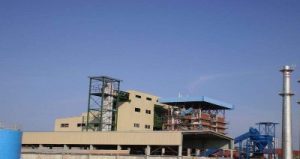
(ii) Hydro-Electric Plant
The alternator pair is connected to the turbine in a hydroelectric plant, which is rotated by water. As a result, the alternator also turns. The electric energy produced by this alternator revolves. This kind of plant is put in front of any river or dam.

(iii) Petrol or Diesel Power Plant
Diesel or gasoline are the fuel sources for this kind of plant. In this kind, a gasoline or diesel engine powers the alternator to produce power.

(iv) Nuclear Power Plant
The fission of uranium atoms produces heat in nuclear power plants, which is utilized to heat water to produce steam and turn a coupled turbine-alternator.
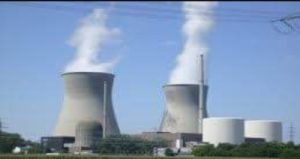
(b) Non - Conventional Method
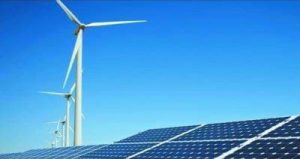
This approach uses a variety of energy sources to produce electricity, including wind, geothermal, tidal, fuel cells, thermoelectric, and thermionic converters. This technique does not produce any pollution when producing electricity. Yet, at the commercial level, this kind of power generation produces very little power.
Grid Architecture:
Power distribution grid architecture affects the resilience and reliability of the system by dictating how electricity moves through it. Important grid structures consist of:
- System of Radial Distribution: This type of distribution is simple but prone to failures since power travels in a single direction from the substation to the consumers.
- Loop Distribution System: Loop systems increase complexity while improving dependability by introducing redundancy by allowing power to flow through several channels.
- Network Distribution System: Typically found in metropolitan areas, network systems offer even more redundancy by allowing power to flow across interconnected paths.
Smart Grid Technologies:
Smart grids are replacing traditional power distribution systems with advanced technology integration, allowing for improved control, monitoring, and optimization. Important smart grid technologies consist of:
- Advanced Metering Infrastructure (AMI): AMI helps utilities to gather energy consumption data in real time, which makes load management, demand response, and invoicing easier.
- Distribution Automation: By automatically detecting and responding to failures, automation technologies including sensors, switches, and control systems reduce outage times and boost dependability.
- Demand Response: In order to lessen the burden on the grid and cut expenses, demand response programs encourage consumers to modify their electricity usage during peak hours.
Electrical Power Supply System
There is always an alternative power producing plant outside a town or metropolis. This power plant generates 11 KV of electrical energy, which is too low voltage to transfer across distances. Consequently, the voltage of the electric energy must be raised in order to employ a step-up transformer to transfer it from one location to another.
The voltage of electricity at the intended usage location is lowered with a step-down transformer. A network is the medium that facilitates the transmission of alternating electricity for supply between locations. Two major components may be distinguished in this network.
(i) Transmission System
Under the transmission system is where the transmission line is located. The distribution line and the generating power station are connected by a transmission line. Long-distance energy power delivery is accomplished by transmission lines. There are two components to a transmission line.
- Primary Transmission Line
- Secondary Transmission Line
Distance is the defining factor that separates these two transmission lines. Long-distance electrical energy supply transmission is accomplished using primary transmission lines. Electric electricity is transported via massive towers in this kind of line.
High voltages, such 110, 132, 400, or 750 KV, are used to transmit electricity, depending on how far away the primary transmission line is. The major transmission line is the one that runs from the generating power plant to the grid power substation. Its length depends on the quantity of power to be transported and the stability of the system.

For long and medium-distance transmission of electrical energy supply, secondary transmission lines are utilized. In this kind of line, rail or tubular poles are used to transmit electric energy. Power is transferred at a high voltage of 33 or 66 KV across this secondary transmission line. Secondary transmission is the line that runs from the receiving substation to the grid power; substation.
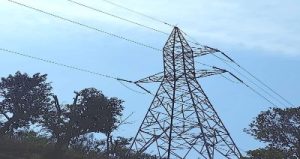
(ii) Distribution System
The distribution Network is positioned beneath the distribution line. Electrical supplies are transmitted across short distances via distribution lines. The distribution line is split into two halves.
- Primary Distribution Line
- Secondary Distribution Line
Primary distribution voltages range from 11,6.6 to 3.3 KV, depending on what the bulk consumer needs. Large factories and industries get their electricity from the receiving power substation directly via the major distribution line.
Secondary distribution voltage is 415/240v, and it’s used for only 3 phase power supply load for 415v and single phase electric supply load for 240v. Small industries which require very low load are given three-phase power supply 415v. Single phase 230v supply is provided to domestic and commercial consumers.
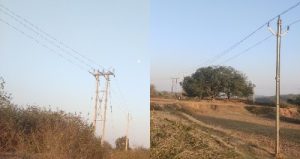
(i) Feeders
The feeder is the medium that carries electrical energy from the distribution transformer to the receiving station. These feeders don’t allow for direct consumer tapping. The feeders always run at the same current.
A compounding generator is a type of generator that is used to make up for drops in feeder voltage caused by various factors.

(ii) Distributors
Conductors are used to connect the supply to the distributor, distribution transformer, and consumer service main box.
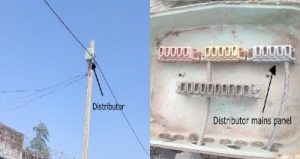
(iii) Service Main
A service main is a kind of wire or cable that is attached to a distributor’s location and provides power to customers based on demand.
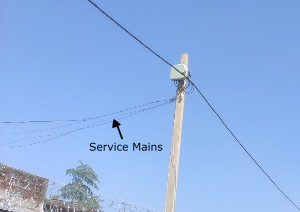
Challenges and Solutions:
The following issues must be resolved for power distribution systems to be dependable and sustainable:
- Aging Infrastructure: The aging infrastructure of many electricity distribution networks contributes to higher maintenance costs, reliability issues, and increased susceptibility to extreme weather events. To overcome these obstacles, modernization and infrastructural enhancements must be funded.
- Renewable Integration: Because renewable energy sources are scattered geographically and have an intermittent character, integrating them can be difficult. Examples of these sources are wind and solar power. Enabling renewable energy integration requires solutions like enhanced forecasting techniques, flexible grid management tactics, and grid-scale energy storage.
- Cybersecurity Risks: With increased connectivity and digitization, power distribution systems are exposed to ransomware attacks, malware, and hacking. To protect the integrity and dependability of the grid, strong cybersecurity measures must be put in place, including as encryption, intrusion detection systems, and personnel training.
Future Trends:
Power distribution networks will be shaped in the future by a number of developing trends:
- Decentralized Energy Systems: By dispersing energy production, distributed generation technologies—such as microgrids, rooftop solar, and community-owned renewable energy projects—allow local communities to produce and use electricity on their own.
- Energy Storage: Through increased grid flexibility, improved integration of renewable energy sources, and more resilience against outages, advancements in energy storage technologies—such as batteries, pumped hydro, and thermal storage—are completely changing the way power is distributed.
- Transportation Electrification: It is anticipated that the use of electric vehicles (EVs) will lead to a rise in power demand and a modification of load profiles in the transportation sector. In order to properly manage EV charging, power distribution systems must change to meet this rising demand, make investments in the infrastructure needed for charging, and put intelligent charging techniques into practice.
Define electric power
In an electrical circuit, power is the rate at which energy is transferred by means of electrical work. Under electric work, it entails the transfer of electrons or electric charge.
then electric power( P) =\dfrac{electric work( W) }{time( t) }.
but electric work(W) = electric potential difference(V) x electric charge(Q)
again electric power(P) = \dfrac{{V}{Q}}{t}
in coulomb’s law(Q) = It
so electric power(P) = \dfrac{VIt}{t}
SI Unit of electric power = watts.
